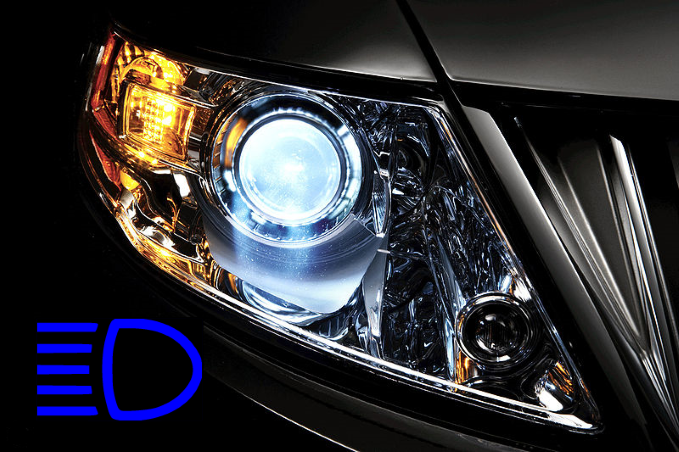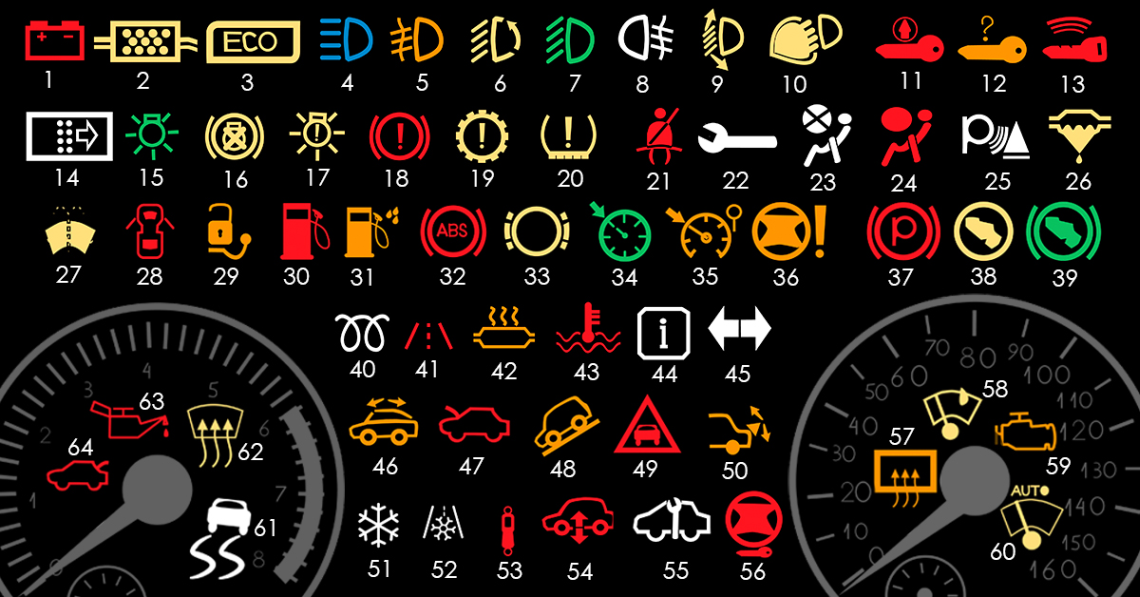
Lights (Controls)
? Questions:
🛈 Information:
Headlights:
Low beam: This is the standard setting to be used under most conditions. If your car is not fitted with Daytime Running Lights, then it is good to use during the daytime to make you more visible to other road users. High Beam: Night driving is dangerous because of both lack of visibility as well as limited v iewing range, therefore use at night along roads that are not well lit. Change to low beam whenever there are any vehicles in front of you, whether oncoming or traveling in the same direction, even if the vehicle is a long distance away. See the section on nocturnal animals and the use of headlights. Do not use during the daytime. Do not use in fog, use the Fog Lights instead. To ensure that the high beam is not on, unless intended, check periodically for the high beam light on the dashboard, as indicated in the accompanying picture.
Daytime Running Lights (DRL):
Designed to make you more visible during the day. If your car is not fitted with DLR, use the low beam headlights during the day. Do not use for night driving. Do not use for fog, use fog lights instead.
Fog Lights :
Designed and positioned low down to reduce reflective glare from the fog. Can also be used for heavy rain and dust storms. Do not use as a replacement for other lights under non-foggy conditions.
Park ing Lights :
As the name indicates, parking lights are to be used when the car is parked, not while driving. They are not a substitute for headlights. Designed to make the car more visible when parked in an area that makes it vulnerable to passing traffic.
Tail Lig hts :
Using your headlights during the day will also activate your tail lights to make you more visible to other road users behind you. Replace any dead bulb immediately, because at night a fast-approaching vehicle from behind may think it is a motorcycle ahead due to seeing only one tail light and collide into the side with no tail light working.
Brake Lights :
Due to the important role they serve, make sure that all your brake lights are working and replace immediately any that are not. When needing to slow down in higher speed traffic and a fast approaching vehicle from the rear, you may want to lightly press and release the brakes a number of times so that the brake lights flash on and off as a warning signal.
Hazard Lights:
When to use: Wherever your vehicle is positioned that would pose a hazard. Being pulled over by law enforcement. Involved in an accident. Car breaks down. Changing a tire on the side of the road. Driving in a funeral procession. If you are slowing down or stopped and there is a fast- approaching vehicle from the rear. When not to use: If there is no hazard and could be confusing to other road users. Driving in bad weather. Illegal parking. Slowing down to exit highway. Driving in heavy traffic. A turn signal will suffice.
Cabin Light:
Used to light the inside of the cabin. Do not drive with the cabin light on, especially at night which can reduce your outside vision.
? When should you have car lights on?
Low Visibility : Turn on your headlights whenever visibility is reduced, such as during dusk, dawn, rain, fog, snow, or any other weather conditions that diminish visibility. Nighttime Driving : By law, headlights must be turned on after sunset and before sunrise to ensure your vehicle is visible to others on the road. Tunnel Driving : Headlights should be turned on when driving through tunnels, as it helps improve visibility for both you and other drivers. Inclement Weather : Anytime you use your windshield wipers due to rain, sleet, snow, or fog, it's recommended to also turn on your headlights. This improves your visibility to others. Overcast Days : On heavily overcast days where natural light is significantly reduced, using headlights can enhance your vehicle's visibility.
Additional Tips:
Daytime Running Lights (DRLs) : Many modern vehicles are equipped with daytime running lights that automatically turn on when the engine is running. These lights enhance your vehicle's visibility during daytime hours but may not activate the taillights, so it's important to manually turn on your headlights in low-light conditions. High Beams : Use high beams on dark, unlit roads or highways where there is no oncoming traffic. Switch to low beams when approaching other vehicles to avoid blinding other drivers. Parking Lights : Use parking lights when parked on the side of the road or in situations where you need to increase visibility without using headlights.
Safety Reminder:
? Do car lights drain battery?
Type of Lights : Different lights on your car have varying power consumption rates. For example, headlights typically use more power than interior lights or parking lights. Duration : The longer you keep your lights on, the more they will drain the battery. For instance, leaving your headlights on while the engine is off for an extended period can significantly drain the battery. Battery Condition : A healthy, fully charged battery can withstand longer periods with lights on compared to a battery that is old, weak, or already partially discharged.
Managing Battery Drain:
Use Lights Wisely : Turn off unnecessary lights when not needed, especially when the engine is off. Regular Maintenance : Ensure your battery is in good condition by performing regular checks and maintenance. This includes checking for corrosion on terminals, ensuring proper fluid levels (for non-sealed batteries), and testing the battery's voltage periodically. Alternator Functionality : The alternator recharges the battery while the engine is running. If you notice frequent battery drain issues, have your alternator checked to ensure it is functioning properly. Battery Saver Features : Some modern vehicles are equipped with battery saver features that automatically turn off lights and other electrical systems if they are left on for an extended period with the engine off.
🛈 Dashboard Warning Lights
Symbol meaning: Person Name - Location Symbol meaning: Person Name - Location Symbol meaning: Person Name - Location Symbol meaning: Person Name - Location Symbol meaning: Person Name - Location Symbol meaning: Person Name - Location Symbol meaning: Person Name - Location Symbol meaning: Person Name - Location Symbol meaning: Person Name - Location Symbol meaning: Person Name - Location Symbol meaning: Person Name - Location Symbol meaning: Person Name - Location Symbol meaning: Person Name - Location Symbol meaning: Person Name - Location Symbol meaning: Person Name - Location Symbol meaning: Person Name - Location Symbol meaning: Person Name - Location Symbol meaning: Person Name - Location Symbol meaning: Person Name - Location Symbol meaning: Person Name - Location Symbol meaning: Person Name - Location Symbol meaning: Person Name - Location Symbol meaning: Person Name - Location Symbol meaning: Person Name - Location Symbol meaning: Person Name - Location Symbol meaning: Person Name - Location Symbol meaning: Person Name - Location Symbol meaning: Person Name - Location Symbol meaning: Person Name - Location Symbol meaning: Person Name - Location Symbol meaning: Person Name - Location Symbol meaning: Person Name - Location Symbol meaning: Person Name - Location Symbol meaning: Person Name - Location Symbol meaning: Person Name - Location Symbol meaning: Person Name - Location Symbol meaning: Person Name - Location Symbol meaning: Person Name - Location Symbol meaning: Person Name - Location Symbol meaning: Person Name - Location Symbol meaning: Person Name - Location Symbol meaning: Person Name - Location Symbol meaning: Person Name - Location Symbol meaning: Person Name - Location Symbol meaning: Person Name - Location Symbol meaning: Person Name - Location Symbol meaning: Person Name - Location Symbol meaning: Person Name - Location Symbol meaning: Person Name - Location Symbol meaning: Person Name - Location Symbol meaning: Person Name - Location Symbol meaning: Person Name - Location Symbol meaning: Person Name - Location Symbol meaning: Person Name - Location Symbol meaning: Person Name - Location Symbol meaning: Person Name - Location Symbol meaning: Person Name - Location Symbol meaning: Person Name - Location Symbol meaning: Person Name - Location Symbol meaning: Person Name - Location Symbol meaning: Person Name - Location Symbol meaning: Person Name - Location Symbol meaning: Person Name - Location Symbol meaning: Person Name - Location

